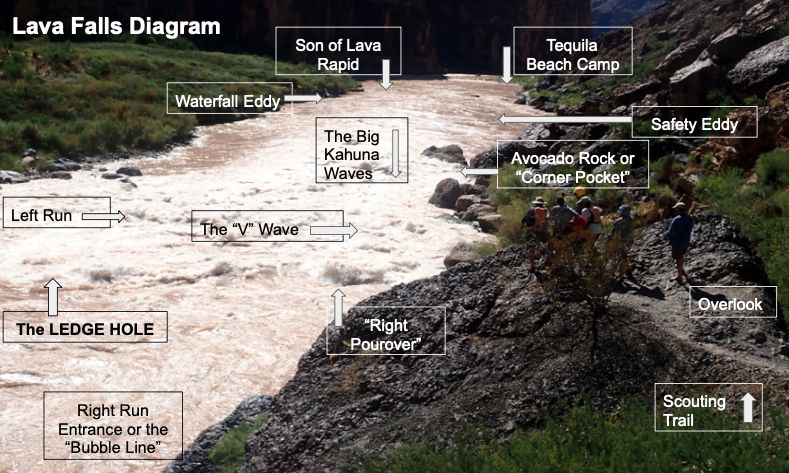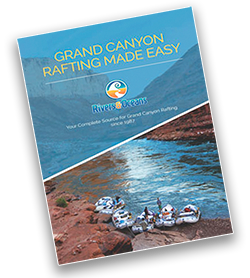
Rafting Lava Falls Rapid
Lava Falls, Grand Canyon National Park
One hundred seventy-nine miles downstream from Lees Ferry on the Colorado River sits Lava Falls Rapid. Difficulty rating of a Class 10 rapid on the 1-10 Grand Canyon scale (Class V on the international scale of river difficulty), Lava Falls is arguably the most famous whitewater rapid in the world. It was even listed by the Guinness Book of World Records as the fastest navigable water in all of North America at 20 m.p.h.

River runners usually spend around 20 seconds in Lava as the rapid drops 37 feet in a hundred yards. Approaching rafters can only see the occasional mist of water spurt up from one of the features hidden below the horizon line. However its thunderous roar can be heard hundreds of yards upstream. While it is possible to portage the rapid on the left shore over 20,000 people run the river each year with only a few walking the trail. Many groups enjoy a post Lava celebratory stop at the aptly named Tequila Beach!
The Ledge Hole
This video shows how a run can last longer than 20 seconds. By missing both the right and left lines and instead hitting the Ledge Hole causing massive carnage.
Scouting Lava Falls
Once rafters see Vulcan’s Anvil they have about one mile of flatwater before arriving at Lava. Most rafters scout from the river right shore. However, during highwater the left line opens up during the peak of the daily flows. Rafters wanting to run the left try to get to Lava Falls early in the morning before the water drops.

Right Scout
Most often scouting takes place on a hill high above the right side of the river. The scout might be worse than the rapid, with sharp black lava rock full heat that cooks rafters and kayakers as they select their lines through the rapid.
Most groups scout on river right when the river is below 15,000 cfs. Guides are looking for the bubble line at the top of the rapid that will take them right of the Ledge and lead them into the V-wave. They are also checking to see if there is a softer spot on the V-Wave and how hard the Big Kahuna is breaking.
Left Scout
Above 15,000 cfs most rafters run the left side of Lava. It is nice to scout from left shore when running left. There is a high scout on the left upstream on a bluff above the rapid. Many boaters prefer the low scout walking downstream to the entrance of Lava.
The left line is considered easier at high water because of the smaller features. However, the entrance is more challenging and requires a careful scout. Due to the tides, the water is higher in the morning and trips wanting to run left will try to get to the rapid before the water drops. Dory trips are known for getting up before dawn Lava morning and pushing down to the rapid.
Find Your Grand Canyon Rafting Adventure…

Find Your Trip
Request a trip search, we’ll find tours meeting your criteria.
*** Our service is free to you and paid for by our partner outfitters. We guarantee you will pay the same price as booking directly with the outfitter.
20 Short Seconds through Lava
Right Line (Classic Run)
A good run through Lava takes between 20 and 25 seconds but inside the whitewater many things can happen. The gigantic Ledge Hole sits in the center of the river below the horizon and is as big as a bus. Boaters try to give the Ledge Hole a wide berth but can’t row too far right or they’ll be pulled by the current into a smaller Ledge Hole, also known as the Pourover, where chances are good that their boat will flip. Guides that have threaded the needle between the Ledge Hole and the Pourover have to prepare for the massive impact of the V-Wave by hitting it squarely.
The V-Wave usually spits out boats upright but rarely in the direction or at the angle a guide prefers. Many boats end up postage stamped onto The Black Rock (aka: Saddle Rock) or caught just upstream in the Corner Pocket. If they make it past those, the “Big Kahuna” wave awaits. A 10-feet high standing wave will break over your raft like a tsunami.
Behind the Big Kahuna is a second wave the rafters want to hit by pivoting their boat to the right to avoid one last opportunity to flip. Motor rafts run the right side at all levels. The water is deeper on the right making it easier for them to use their motors.
Video of the Right Run at Lava Falls
Left Run
The left run is all about having momentum going left entering in a slot just left of the Ledge Hole. Many rafts get too far in the middle so it is best to error to the left. The features in the left line can be abrupt and violent especially for people in the back of the raft. Once through those early moves look for the Big Kahuna on the right side of the river.
Video of Left Line at Lava Falls
Some Firsts!
First Running of Lava Falls Rapid
The first people to run Lava Falls were George Flavell and Ramon Montez in October of 1896. Previous expeditions through the passage including both of Major John Wesley Powell’s expeditions as well as Robert B. Stanton’s survey for the railroad, had portaged and lined around most of the major whitewater. The next time the rapid was run was in 1938 by Buzz Holmstrom and Amos Burg. Amos ran the first inflatable raft through Lava Falls on this descent.
First to Swim Lava
In 1955 Bill Beer and John Daggett swam the entire Grand Canyon including Lava Falls. Upon their completing their multi-week trip the national park service closed the river to swimming. They wrote an entertaining book about their trip.
First to Run Up the Rapid
The first up river run of Lava Falls was by Jon Hamilton in 1960 using a jet boat invented by his father. Jon took two days to navigate all 4 jet boats up the rapid during the only successful upriver run of the Grand Canyon.
Lava Falls Trail
There is much discussion about hiking to Lava Falls. While there is a trail, the final descent is a couple of hundred yards down a nasty lava chute that most one consider nothing like a trail. There are other trails from near the Toroweap Overlook on the North Rim of Grand Canyon National Park that give nice views of the canyon. Hiking in the summer months is not recommended. No matter the time of year bring plenty of water.
The Lava Falls Experience
Running Class X Lava Falls is unforgettable for a reason. There are few places on the planet with rapids as runnable and violent. The rapid is so renown that rapids on other famous rivers are named after Lava including Lava South on the now dammed Bio Bio River and Lava North on the Alsek River of Canada and Alaska. If you are interested in the Lava Falls experience check out our information on rafting the Grand Canyon.
You may also enjoy watching our favorite Grand Canyon rafting videos or reading about the when to raft the Grand Canyon and what types of crafts run the Colorado River.
Bonus Video: Paddle Boating Lava Falls
Paddle rafts see many more swimmers than all the other rafts types. See video of one such adventure.







